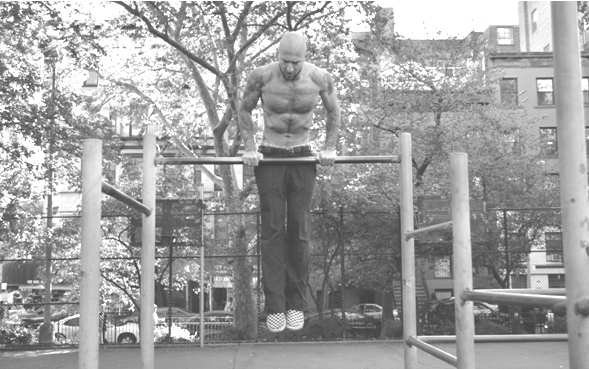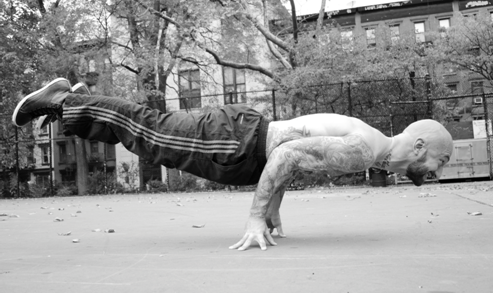I am the man who wrote the book, Convict Conditioning. I am not a perfect man, and my book is not a perfect book; but I hope that when people judge the book, they will say that it got much more right than it got wrong.
They certainly couldn’t say that about the man.
Without improving, evolving, moving forwards, we are nothing. There is no standing still in life—you are either moving forward, or you are losing ground. That’s why I was so excited to be able to contribute to PCC. There is no doubt in my mind that PCC will do for bodyweight training what the RKC has done for kettlebells. And that would be incredible.
A lot of folks have asked me how PCC will be different from Convict Conditioning. I can sum that up in one word: KAVADLO. Al Kavadlo is, for my money, the greatest progressive bodyweight training coach on earth. PCC, as a total system, is much bigger than Convict Conditioning alone because it has been expanded by Al’s methods, tools and tactics. His “new-school” has met my “old-school”, and PCC is the result. PCC is as much Al’s baby as mine—maybe more so. It is flat out false to assume that the PCC is just a “Convict Conditioning cert”. People who love Convict Conditioning will love PCC, because Convict Conditioning forms just a part of PCC. But PCC is more than just Convict Conditioning.
Much more!
PCC: A Black Belt in Bodyweight
Perhaps the most important difference between PCC and Convict Conditioning is the fact that PCC is about principles, not techniques. Convict Conditioning is very easy for athletes to pick up and understand, because it presents six groups of ten techniques. PCC goes deeper than this. Anyone who has ever studied a martial art knows that they need to learn scores of techniques to achieve a black belt; but the closer you get to true mastery, the more you come to understand that it’s not the techniques that matter—nobody can remember a hundred techniques in a fight. What matters are the principles you absorb.
PCC is like this; you will drill and explore dozens of key techniques at the cert workshop; and the PCC Instructor’s Manual analyzes and illustrates over one-hundred and fifty exercises! But at the heart of PCC are the principles of bodyweight progression. Once you grasp these principles, you can make any calisthenics exercise progressive: from a rehab level, right up to epic Bruce Lee-level bad-assery. This is what it’s all about. Some people have accused Convict Conditioning of being too dogmatic; too rigid. Nobody could say the same about PCC, because it’s based on principles, not set exercises paired with progression standards. There is so much more flexibility built in.

- (By Giga Paitchadze – Creative Commons License)
Though they play an important role in the early stage, the techniques should not be too mechanical, complex or restrictive. If we cling blindly to them, we shall eventually become bound by their limitations. —Bruce Lee
The punches and kicks—the 14 chains
A martial artist seeks to absorb principles, but he or she can only absorb the general by accumulating the specific—lots and lots of individual punches, kicks, throws, etc. The road to calisthenics mastery ain’t no different. Bodyweight athletes still need to learn individual techniques. They still need to learn about chains—i.e., technical progression sequences. It’s important to note that the fundamental movement-types in Convict Conditioning are all still present in the PCC system; however they have been expanded and added to. The seven fundamental movement chains in PCC are:
1. Push-ups—building to—one-arm push-ups
2. Pull-ups—building to—one-arm pull-ups
3. Handstand push-ups—building to—full handstand push-ups (between chairs)
4. Horizontal pull-ups—building to—“torquers” (one-arm, one-leg Australian pull-ups)
5. Dips—building up to—strict muscle-ups
6. Leg-raises—building to—strict rollovers
7. Squats—building to—wushu pistols
Anyone who knows Convict Conditioning well will see that all the major movements are here (save bridges, which I’ll address in a sec). Two new movement chains have been added to the system; the first is the horizontal pull-up. The basic form of this exercise will be well (and painfully) known by Convict Conditioning exponents, but here the progressions have been jacked up to an advanced level to add more symmetry to upper-body work (the vertical handstand push-ups and vertical pull-ups are antagonistic opposites; now the horizontal push-up has an antagonistic “buddy” in the horizontal pull-up). Complete dip progressions—missing from CC—have also been included, with these culminating in one of the most popular of Al’s bar moves: the uber-cool muscle-up (known as a sentry pull-up to CCers).

The muscle-up—part pull-up, part dip—is an advanced technique in the PCC dipping chain.
Where CC progressions can still be found in the PCC system, they are often approached differently, thanks to Al’s input. For example hanging straight leg raises are real popular in jails: but we got the feedback from athletes on the outside that they were just too easy. So we have expanded and advanced the progressions, making the advanced techniques much, much harder. One-leg squats have also been made harder. Everything is at a higher turn of the spiral. More progression options have been included for pull-ups and push-ups. Extra handstand pushups variations have been included.
As I have said, the PCC system is much larger than Convict Conditioning. Convict Conditioning is really about building raw muscle and motive power by utilizing fairly basic, fairly brutal, pulling, pushing and leg movements. But bodyweight strength training is about more than that—static holds, for example. Whereas Convict Conditioning didn’t include full progressions for static holds, PCC does. The system includes 7 static chains:
1. Press holds—building to—the elbow lever
2. Midsection holds—building to—the L-hold
3. Bridge holds—building to—the gecko bridge
4. Handstands—building to—the frog-press handstand
5. The back lever—building to—the full back lever
6. The front lever—building to—the full front lever
7. The side lever—building to—the press flag
That’s a pretty damn impressive roll-call of techniques: and very few men or women outside of professional gymnastics could complete all seven. Fewer still could assimilate or teach chains for all seven. But this knowledge is part of the PCC system thanks to Al’s know-how, and has been integrated into PCC because I’ve been asked so often about these holds; athletes want to learn about old school hand-balancing, flags, elbow levers, and so on. Fans of bridges wanted to know how I would include them as a form of static hold. All this is contained in the PCC system. This doesn’t mean you can’t begin using these “holds” as “moves”—levering up from a bridge into a handstand, for example. Remember, everything is about principles, not dogma. Once you understand how to work with the techniques, you can expand; you can explore. You learn the form, you absorb the form, you discard the form.

A bodyweight powerhouse, Al Kavadlo is no stranger to static holds. Perfection!
The PCC Instructor’s Manual will cover all 14 chains in-depth (it’s over 600 pages), but it will only be available to athletes who attend the PCC event. The certification workshop itself cannot cover all 14 chains—over 150 exercises—but it has been painstakingly designed to cover the key techniques, training methods, and the principles behind progression.
The eleven training modules and two seminars over the three-day workshop will revolutionize you: no matter what your level of development. Sure, you may not come away able to perform expert hand-balancing, elbow levers, front-levers, one-arm pull-ups and human flags, but I promise you this: you WILL come away knowing exactly how to get there—or get someone else there—in the best way possible.
Ralph Waldo Emerson—the great Patriot, and possibly the greatest essayist of all time—said this:
As to methods there may be a million and then some, but principles are few. The man who grasps principles can successfully select his own methods. The man who tries methods, ignoring principles, is sure to have trouble.
Come and join us in the PCC community. The principles you need to maximize your bodyweight potential are waiting here for you.
—
Paul Wade is the author of five Convict Conditioning DVD/manual programs. Click here for more information about Paul Wade, and here for more information on Convict Conditioning DVD’s and books available for purchase from the publisher.
